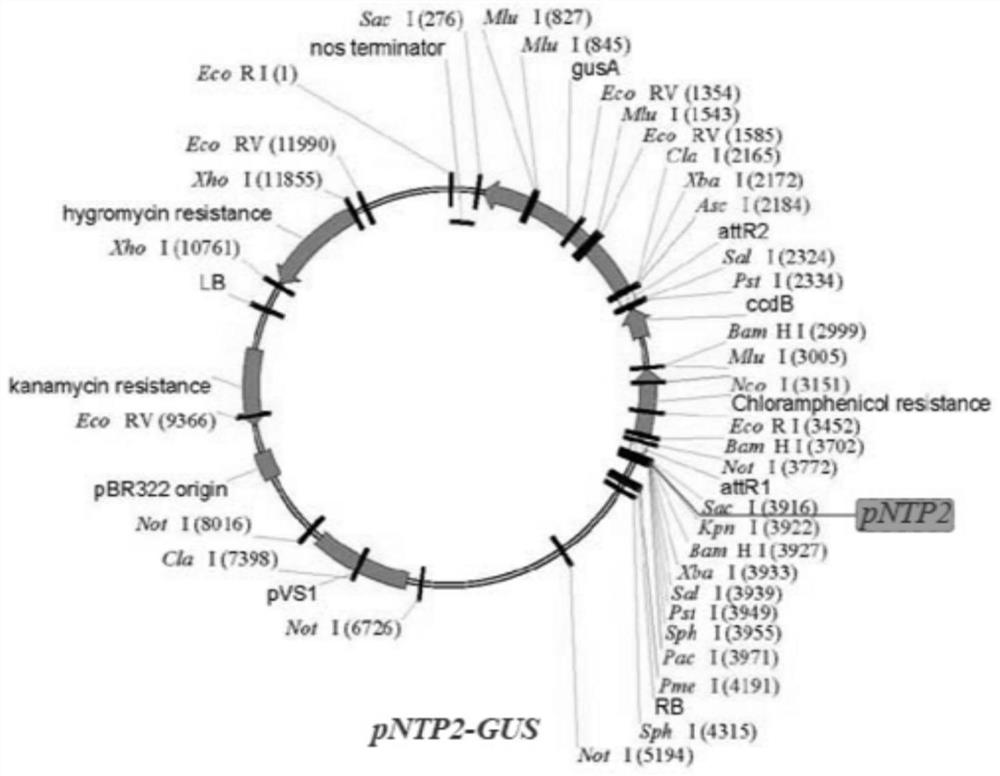Photoinduced gene promoter, recombinant vector, construction method of recombinant vector and recombinant bacteria
A technology of recombinant vectors and recombinant bacteria, applied in the field of genetic engineering, can solve the problems of plant toxicity, difficult control, low efficiency, etc., and achieve the effect of easy screening and good specificity
- Summary
- Abstract
- Description
- Claims
- Application Information
AI Technical Summary
Problems solved by technology
Method used
Image
Examples
preparation example Construction
[0029] In some embodiments, a method for preparing a recombinant vector is also provided, such as figure 1 As shown, it includes the steps:
[0030] S10, using the genomic DNA of wild-type Arabidopsis Col as a template, using an upstream primer with a nucleotide sequence as shown in SEQ ID NO.2 and a downstream primer with a nucleotide sequence as shown in SEQ ID NO.3 to carry out PCR amplification increase to obtain the light-inducible gene promoter NTP2;
[0031] S20. Perform Kpn1 and Sac1 double enzyme digestion on the pMDC162 plasmid vector fused with the GUS reporter gene and the light-inducible gene promoter NTP2, and gel recovery and purification of the enzyme-digested product by gel electrophoresis to obtain the NTP2 fragment after enzyme digestion and pMDC162 plasmid vector after digestion;
[0032] S30. Using T4 ligase to ligate the digested NTP2 fragment into the digested pMDC162 plasmid vector to construct a recombinant vector pNTP2-GUS.
[0033] This example us...
Embodiment 1
[0038] 1) Log in to the Arabidopsis TAIR database (http:www.arabidopsis.org / ), and design a light-inducible gene promoter based on the promoter region about 1.5Kb upstream of the published Arabidopsis NTP2 (NTP2: AT2G40520) gene sequence NTP2 upstream and downstream amplification primers;
[0039] 2), design the upstream and downstream amplification primers of the light-inducible gene promoter NTP2 as follows:
[0040] The nucleotide sequence of the upstream primer is shown in SEQ ID NO.2, and its nucleotide sequence is specifically P15'CACCAAACAATTTGGTATTTGGTT3';
[0041] The nucleotide sequence of the downstream amplification primer is shown in SEQ ID NO.3, and its nucleotide sequence is specifically P2: 5'TTGAACAAAAAACAAAGAGAATCAC3'.
[0042] 3), using the genomic DNA of wild-type Arabidopsis Col as a template, using the above-mentioned double primers to carry out PCR amplification, the obtained PCR product is the light-inducible gene promoter NTP2, and it is subjected to ...
Embodiment 2
[0066] 1), using the flower bud soaking method to stably transform Arabidopsis thaliana of the Col-0 ecotype;
[0067] 1. Transformation adopts flower bud soaking method (document YHQ65), takes the plant that grows about one month, and the growth condition is good, and Arabidopsis thaliana can be done decapping treatment one week in advance before transformation, so that plant produces more flower buds, improves transformation efficiency efficiency.
[0068] ②Shake the Agrobacterium plus tertiary antibody liquid medium containing the transgene carrier, then pipette 200μL and add it to 200mL tertiary antibody liquid medium and shake until the OD 600 is about 1.5-2.0.
[0069] ③ Centrifuge the bacterial solution at 8000 rpm for 10 minutes, discard the supernatant and leave the bacterial cells at the bottom.
[0070] ④ Use 4.4g / L MURASHIGE&SKOOG(MS) BASAL MEDIUMw / VITAMINS solution (containing 5% sucrose solution) to resuspend the bacteria solution, add 0.5μL / mL Silwet surfactant...
PUM
 Login to View More
Login to View More Abstract
Description
Claims
Application Information
 Login to View More
Login to View More - R&D
- Intellectual Property
- Life Sciences
- Materials
- Tech Scout
- Unparalleled Data Quality
- Higher Quality Content
- 60% Fewer Hallucinations
Browse by: Latest US Patents, China's latest patents, Technical Efficacy Thesaurus, Application Domain, Technology Topic, Popular Technical Reports.
© 2025 PatSnap. All rights reserved.Legal|Privacy policy|Modern Slavery Act Transparency Statement|Sitemap|About US| Contact US: help@patsnap.com



